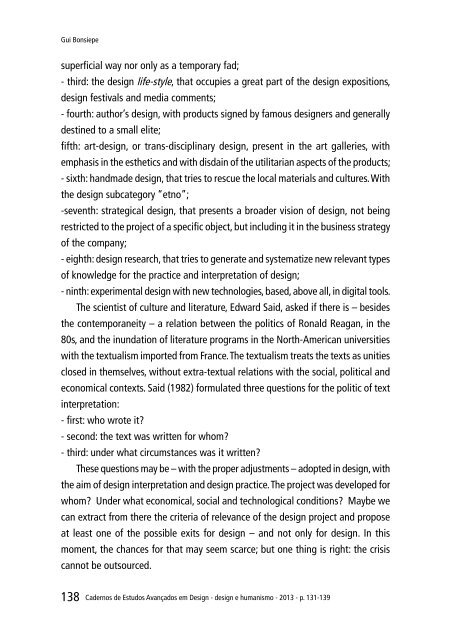o_19po8js951tvs1r0t1r8s4bb1vpla.pdf
Create successful ePaper yourself
Turn your PDF publications into a flip-book with our unique Google optimized e-Paper software.
Gui Bonsiepe<br />
superficial way nor only as a temporary fad;<br />
- third: the design life-style, that occupies a great part of the design expositions,<br />
design festivals and media comments;<br />
- fourth: author’s design, with products signed by famous designers and generally<br />
destined to a small elite;<br />
fifth: art-design, or trans-disciplinary design, present in the art galleries, with<br />
emphasis in the esthetics and with disdain of the utilitarian aspects of the products;<br />
- sixth: handmade design, that tries to rescue the local materials and cultures. With<br />
the design subcategory “etno”;<br />
-seventh: strategical design, that presents a broader vision of design, not being<br />
restricted to the project of a specific object, but including it in the business strategy<br />
of the company;<br />
- eighth: design research, that tries to generate and systematize new relevant types<br />
of knowledge for the practice and interpretation of design;<br />
- ninth: experimental design with new technologies, based, above all, in digital tools.<br />
The scientist of culture and literature, Edward Said, asked if there is – besides<br />
the contemporaneity – a relation between the politics of Ronald Reagan, in the<br />
80s, and the inundation of literature programs in the North-American universities<br />
with the textualism imported from France. The textualism treats the texts as unities<br />
closed in themselves, without extra-textual relations with the social, political and<br />
economical contexts. Said (1982) formulated three questions for the politic of text<br />
interpretation:<br />
- first: who wrote it?<br />
- second: the text was written for whom?<br />
- third: under what circumstances was it written?<br />
These questions may be – with the proper adjustments – adopted in design, with<br />
the aim of design interpretation and design practice. The project was developed for<br />
whom? Under what economical, social and technological conditions? Maybe we<br />
can extract from there the criteria of relevance of the design project and propose<br />
at least one of the possible exits for design – and not only for design. In this<br />
moment, the chances for that may seem scarce; but one thing is right: the crisis<br />
cannot be outsourced.<br />
138<br />
Cadernos de Estudos Avançados em Design - design e humanismo - 2013 - p. 131-139



